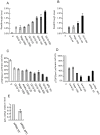Readthrough of premature termination codons in the adenomatous polyposis coli gene restores its biological activity in human cancer cells
- PMID: 21909382
- PMCID: PMC3166079
- DOI: 10.1371/journal.pone.0024125
Readthrough of premature termination codons in the adenomatous polyposis coli gene restores its biological activity in human cancer cells
Abstract
The APC tumor suppressor gene is frequently mutated in human colorectal cancer, with nonsense mutations accounting for 30% of all mutations in this gene. Reintroduction of the WT APC gene into cancer cells generally reduces tumorigenicity or induces apoptosis. In this study, we explored the possibility of using drugs to induce premature termination codon (PTC) readthrough (aminoglycosides, negamycin), as a means of reactivating endogenous APC. By quantifying the readthrough of 11 nonsense mutations in APC, we were able to identify those giving the highest levels of readthrough after treatment. For these mutations, we demonstrated that aminoglycoside or negamycin treatment led to a recovery of the biological activity of APC in cancer cell lines, and showed that the level of APC activity was proportional to the level of induced readthrough. These findings show that treatment with readthrough inducers should be considered as a potential strategy for treating cancers caused by nonsense mutations APC gene. They also provide a rational basis for identifying mutations responsive to readthrough inducers.
Conflict of interest statement
Figures



Similar articles
-
Serum starvation enhances nonsense mutation readthrough.J Mol Med (Berl). 2019 Dec;97(12):1695-1710. doi: 10.1007/s00109-019-01847-0. Epub 2019 Nov 15. J Mol Med (Berl). 2019. PMID: 31786671
-
Restoration of APC gene function in colorectal cancer cells by aminoglycoside- and macrolide-induced read-through of premature termination codons.Gut. 2010 Apr;59(4):496-507. doi: 10.1136/gut.2008.169805. Epub 2009 Dec 1. Gut. 2010. PMID: 19951906
-
Characterization of new-generation aminoglycoside promoting premature termination codon readthrough in cancer cells.RNA Biol. 2017 Mar 4;14(3):378-388. doi: 10.1080/15476286.2017.1285480. Epub 2017 Feb 1. RNA Biol. 2017. PMID: 28145797 Free PMC article.
-
Pharmaceuticals Promoting Premature Termination Codon Readthrough: Progress in Development.Biomolecules. 2023 Jun 14;13(6):988. doi: 10.3390/biom13060988. Biomolecules. 2023. PMID: 37371567 Free PMC article. Review.
-
[Therapeutic readthrough strategy for suppression of nonsense mutations in duchenne muscular dystrophy].Brain Nerve. 2011 Nov;63(11):1253-60. Brain Nerve. 2011. PMID: 22068478 Review. Japanese.
Cited by
-
A novel Werner Syndrome mutation: pharmacological treatment by read-through of nonsense mutations and epigenetic therapies.Epigenetics. 2015;10(4):329-41. doi: 10.1080/15592294.2015.1027853. Epigenetics. 2015. PMID: 25830902 Free PMC article.
-
Translational readthrough potential of natural termination codons in eucaryotes--The impact of RNA sequence.RNA Biol. 2015;12(9):950-8. doi: 10.1080/15476286.2015.1068497. RNA Biol. 2015. PMID: 26176195 Free PMC article. Review.
-
Stop codons and the +4 nucleotide may influence the efficiency of G418 in rescuing nonsense mutations of the HERG gene.Int J Mol Med. 2019 Dec;44(6):2037-2046. doi: 10.3892/ijmm.2019.4360. Epub 2019 Oct 1. Int J Mol Med. 2019. PMID: 31573043 Free PMC article.
-
CTELS: A Cell-Free System for the Analysis of Translation Termination Rate.Biomolecules. 2020 Jun 16;10(6):911. doi: 10.3390/biom10060911. Biomolecules. 2020. PMID: 32560154 Free PMC article.
-
Nonsense Suppression as an Approach to Treat Lysosomal Storage Diseases.Diseases. 2016 Dec;4(4):32. doi: 10.3390/diseases4040032. Epub 2016 Oct 19. Diseases. 2016. PMID: 28367323 Free PMC article.
References
-
- Aoki K, Taketo MM. Adenomatous polyposis coli (APC): a multi-functional tumor suppressor gene. J Cell Sci. 2007;120:3327–3335. - PubMed
-
- Kolligs FT, Bommer G, Goke B. Wnt/beta-catenin/tcf signaling: a critical pathway in gastrointestinal tumorigenesis. Digestion. 2002;66:131–144. - PubMed
-
- Groden J, Joslyn G, Samowitz W, Jones D, Bhattacharyya N, et al. Response of colon cancer cell lines to the introduction of APC, a colon-specific tumor suppressor gene. Cancer Res. 1995;55:1531–1539. - PubMed
Publication types
MeSH terms
Substances
LinkOut - more resources
Full Text Sources
Other Literature Sources
Medical

